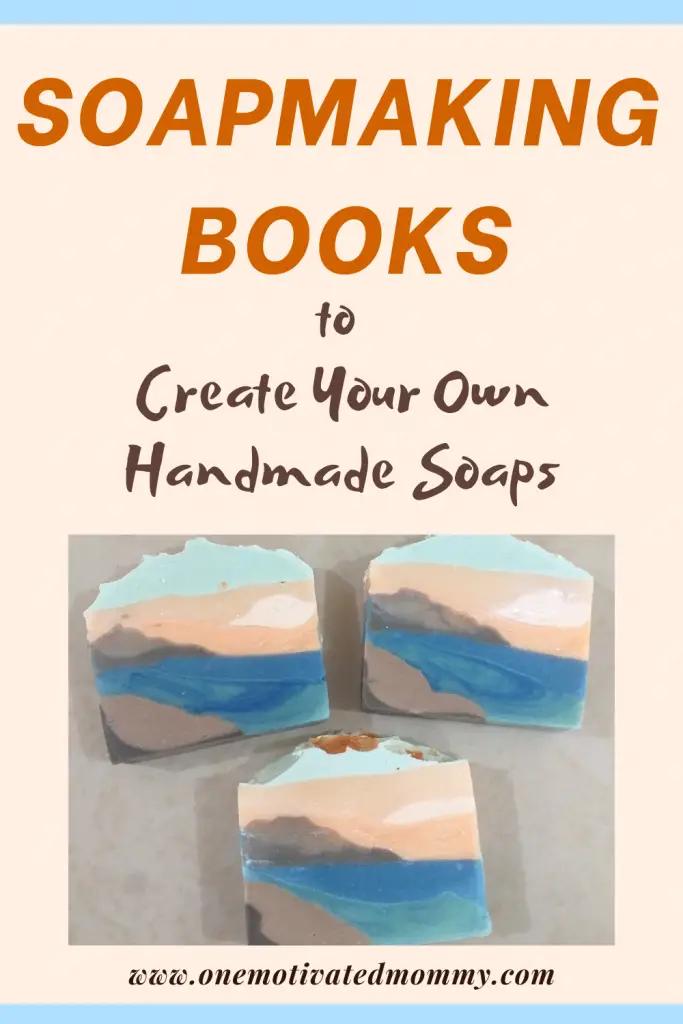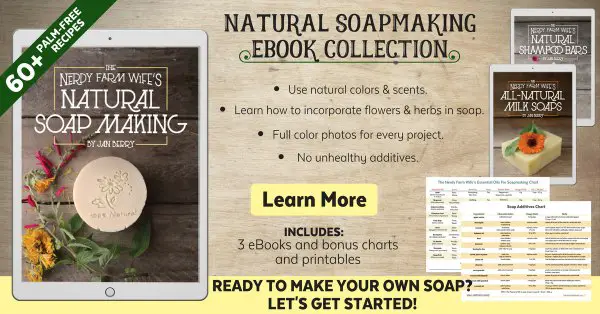There are many resources online to learn how to make soaps at home, however, in my opinion, it does not compare to having your own soapmaking books, as you have access to a wealth of information in one place.
Soapmaking is a very rewarding endeavour whether as a hobby or as a business.
There is so much satisfaction in using a luxurious bar of soap that you made yourself with skin-loving, nourishing ingredients and fragrances that you love and not the harsh chemicals and detergents of commercial soap.
As a self-confessed bibliophile and lover of all things soap, I personally own a number of soapmaking books both in print and on my Kindle. They all provide knowledge that will assist anyone on the soapmaking journey.
Soapmaking Books To Create Your Own Handmade Soaps
Simple and Natural Soapmaking by Jan Berry

Jan Berry, also known as The Nerdy Farmwife is a veteran soapmaker, teacher, author and herbalist.
Simple and Natural Soapmaking is packed with guidelines, tips and techniques to create beautiful, natural cold process handmade soaps.
All the recipes in the book are palm free, naturally scented with essential oils, and use botanicals and clays for natural colouring.
This book features colour photographs that show what to look for to determine when ‘trace’ is achieved, the stages of hot process soap as well as stunning pictures of finished soaps.
Jan also teaches you how to create infused oils and enhance your soaps with additives such as herbs and milks.
There is also a handy section on troubleshooting that would be valuable to any soapmaker.
This is a great book for aspiring soapmakers as Jan walks you through creating your first batch of soap. One of my favourite recipes from this book is the Creamy Shea Butter Bastille Soap which in my opinion is a good beginner recipe to try.
The Soapmaker’s Companion by Susan Miller Cavitch

This is one of the most popular soapmaking books as it has been around since 1997. It is indeed a comprehensive guide and excellent addition to any soapmaker’s library.
Ms. Cavitch provides information on the science involved in saponification, soap characteristics produced by different carrier oils and fats, colourants, properties and benefits of essential oils and herbs, as well as different soap design techniques.
There is a combination of recipes, formulas and even a farm soap named ‘EIEIO’ which contains rich ingredients like goat’s milk, oatmeal, beeswax and egg yolks (I need to try this one).
I particularly like that the book expands on how to create other products other than just cold process soap such as; homemade laundry soap, moisturizing cream, lip balm, liquid soap and transparent soaps.
There are troubleshooting and frequently asked sections that deal with common soaping issues like soda ash and seizing, as well as a valuable writeup on how to start a soapmaking business titled, ‘Soapmaking in the Marketplace’.
Although there are no photographs in the book, it contains lots of illustrations to demonstrate the different steps.
The Soapmaker’s Companion is one book that I would recommend to a new soapmaker to understand various aspects of soaping.
Scientific Soapmaking by Kevin M. Dunn
I appreciate Dr. Kevin Dunn and his contribution to the soapmaking community. I look out for online videos and conferences where he is featured, because I always learn something new.
Scientific Soapmaking is not one of your typical soapmaking books. It is written like a chemistry textbook and has practice problems and equations.
But don’t let that intimidate you. This book is wonderful for someone who wants an in-depth understanding of the chemistry behind the soapmaking process.
I particularly love that Professor Dunn shows you how to make small single bar quantities of soap for testing purposes and encourages you to experiment to see how various fatty acid profiles in oils create different qualities of soap.
Some of the topics covered include: Tools of the Trade, Basic Chemistry, Saponification, Quality Control, Quality Assurance and Research and Development.
This book may seem advanced for a beginner, but if you want to learn more about the science of soapmaking, this is definitely one book to have in your library.
Essentially Soap by Dr. Robert S. McDaniel

I learned about Dr. Robert McDaniel from Kevin Dunn in his Scientific Soapmaking book.
It was curiousity more than anything that led me to acquire a copy of this book for myself. Dr. McDaniel (also known as Dr. Bob), has a Bachelor of Science in Chemistry and a PhD in Organic Chemistry. His soapmaking book, Essentially Soap, published in the year 2000, is very beginner-friendly. It features everything you should know from safety, equipment, basic ingredients, blending your own essential oil fragrances, additives and exfoliants.
Although there are no instructions for hot process soap, there are 25 cold process soap recipes which include recipes for shaving soap, facial bars, castile soap and pet shampoo bars. There are also lots of photographs throughout the text.
The love for soapmaking definitely is displayed in this book. One thing that impressed me is the way Dr. McDaniel simplifies the craft. He takes away the initial intimidation that usually looms when thinking about starting to make soap. The language is very gentle and conversational and you feel as though he is there walking you through step-by-step.
The Everything Soapmaking Book by Alicia Grosso

I must admit that I initially got this book for Kindle, but I found that I prefer the physical version.
The Everything Soapmaking Book is very thorough, in my opinion, in that it teaches you how to create different types of soaps and has recipes for each type – a great guide for the novice or experienced soapmaker.
There is an abundance of information on topics like, equipment, ingredients, molds, fragrance, colour, embeds, milling and more!
Cold process, hot process, liquid, transparent, and cream soaps are all included in this book by Alicia Grosso. I made my first batch of liquid soap, without any problems by following her recipe which was well-laid-out from start to finish.
There are lots of recipes and tons of facts, tips, and techniques scattered throughout the book to help you perfect your soap. There is even a section on packaging ideas for gifting soaps on special occasions like Valentine’s Day or Christmas.
Personally, I would have preferred some of the demonstrative photographs to be in full colour, rather than green, as they are difficult to see.
I especially appreciate the section on how to turn your soapmaking passion into a business and tips on selling at events like craft fairs, bazaars and farmers’ markets.
Hot Process Soap Making by Heidi Villegas

Heidi Villegas is a certified aromatherapist and herbalist and writes at her website, Healing Harvest Homestead.
I love hot process soaps due to the fact that they can be used sooner than soaps made with the cold process method as well as the ability to include additives after ‘the cook’ where they remain unaffected by lye during saponification.
Heidi believes in keeping things simple and shares her tried and true hot process soap recipe. She takes you through the tools required, safety guidelines and the methodology involved in hot process.
She then further teaches you how to work with herbs, flowers, infusions, herbal powders and clays to naturally colour soap and/or add exfoliants to create a variety of soaps.
There is an emphasis on the use of natural ingredients and essential oils. One of her most popular soaps is the ‘Sexy Wild Man’ and she shares her essential oil blend for this recipe among other interesting and unique blends.
The book also has beautiful colour photographs that show the various stages in the cooking process.
To anyone looking to make hot process soaps, I recommend Hot Process Soapmaking by Heidi Villegas.
Making Soap From Scratch: How to Make Handmade Soap – A Beginners Guide and Beyond by Gregory Lee White

Gregory White is a professional soap artisan and a certified clinical aromatherapist who has been making soap for decades.
This book, Making Soap From Scratch, is truly a good book for beginners. I like that Mr. White has a way of breaking down the soapmaking process so that it is not intimidating.
He takes you through soapmaking terms, equipment, types of carrier oils in soap, and of course the procedure to making cold process soaps.
Being an aromatherapist, he has a section on essential oils, their properties, benefits and uses.
There are a few recipes using animal fats like lard and tallow, however the majority of recipes are vegan-friendly.
Mr. White goes into detail on how he makes soap using the Master Batch method where he premixes the carrier oils. He then follows up by giving recipes using the master batch oils.
There is also information and guidance on selling handmade soaps to patrons of craft fairs, bed and breakfasts, stores and boutiques, and other business tips such as labeling and packaging.
I would prefer if this book had more photographs to accompany the instructions so that a newcomer to soapmaking would have a visual idea of the procedures involved.
Soap Crafting – Step-by-Step Techniques for Making 31 Unique Cold-Process Soaps by Anne Marie Faiola

Almost every soapmaker is familiar with The Soap Queen and founder of Bramble Berry, Anne Marie Faiola.
Anne Marie is a true veteran in the handmade soap arena, making soap since she was 16 years old. She has a number of tutorials on making different types of soap on the Soap Queen TV YouTube channel as well as the Bramble Berry website.
Her book, Soap Crafting, is a good book for beginners as she touches on all aspects of the soapmaking process inclusive of safety guidelines, soaping vocabulary, equipment and instructions on how to make cold process soap.
Also, she explains different types of colourants and how to use both essential and fragrance oils in soap.
There is a section on popular carrier oils used to make soap, detailing their properties, INCI name and SAP values.
Each individual recipe comes with thorough instructions and safety guidelines. The recipes include techniques for different design methods such as swirls, ombre, funnel pour, colour blocking, stained glass, cupcake soaps and more.
There also are lots of pictures that would be helpful to a beginner.
I highly recommend this book especially if you are interested in the artistic side of soapmaking.
As I add to my library of soapmaking books, I will surely be sharing with you as I go along. Feel free to let me know about your favourite soapmaking resources.
Happy Soaping 🙂










